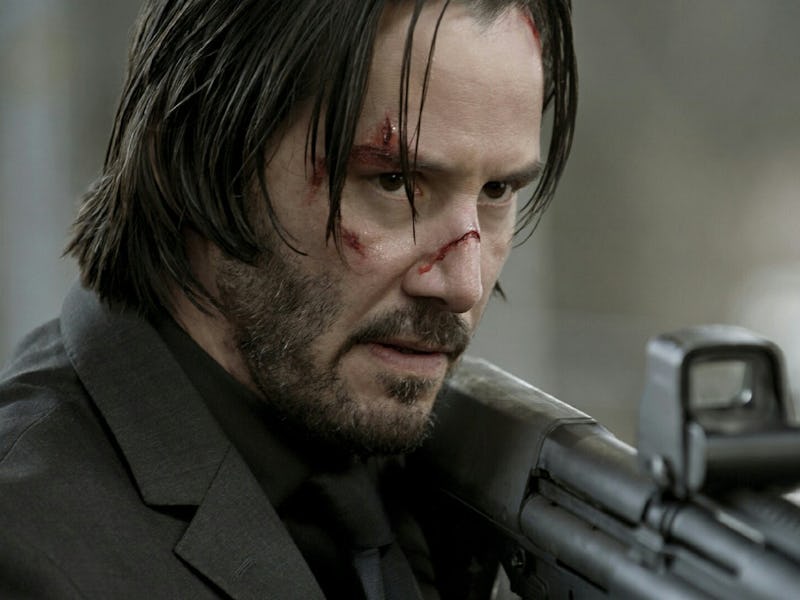The Weird Assassin’s Economy of 'John Wick' Is a Legit Black Market
The heightened Wick universe is actually kind of similar to real-life organized crime.

Both John Wick and its sequel operate on two levels: On the surface, they are balls-to-the-wall action movies about what happens when a man seeks bloody revenge. But just beneath that, they’re also stylized portraits about a lifelong member of an organized crime syndicate attempting to free himself from its interconnected web. And that is particularly difficult because the John Wick universe suggests that the world its main character inhabits has a mysterious insular framework. It’s all dictated by a sense of loyalty, unregulated currencies, and a unique code of conduct. It’s a heightened reality, but the Keanu Reeves-led world might not be too different from real-life organized crime.
To get to the bottom of what makes the Wick underworld tick, we spoke with Yuliya Zabyelina, an Assistant Professor at John Jay College of Criminal Justice. Zabyelina specializes in black markets, informal economies, and transnational organized crime, aka everything John Wick is about.
Criminal Currency
In John Wick’s world, everything from hotel check-ins to bespoke tailoring is paid for in gold coins. It’s got to be a pain in the ass to lug around heavy doubloons for every possible transaction, but Zabyelina sees them as a representation of the criminal underworld as a whole.
While gold coins aren’t used by organized crime for payments these days, she said, “Those coins represent the code of conduct they use to regulate the activities of criminal organizations.” You have a currency, and you have legitimate rules regardless of whether those coins have actual value or not.
But the coins as literal forms of payment aren’t too far off, either. Zabyelina explained real criminals have specific, old-school ways to pay for services. “Sometimes they pay in favors. Sometimes they use diamonds,” she said. “Those are small and easy to conceal. Criminal organizations also obviously love cash because there isn’t a paper trail. There are also cryptocurrencies like Bitcoin.”
Contract Killers
Wick shows allegiance to the band of assassins based at the Continental in New York, but he’s primarily a killer for hire. The larger universe introduced in the sequel posits these interconnected assassins operating on a shared code of conduct, but they could easily turn based on the highest bidder. Chapter 2 sees Wick forced to go to Italy to knock off a member of the Camorra, a detail Zabyelina sees as none too far from reality.
“John Wick is a freelancer, so the film addresses commons fears among national security experts because it shows that criminals in different organizations can cooperate,” she explained. Despite the fact that Wick is driven by a sort of personal vengeance, she said the films accurately show that criminal organizations can make bloody peace.
Blood Oaths and Markers
While the original film’s inciting incident was the murder of Wick’s beloved pooch, Chapter 2 uses Wick’s own organized crime allegiances against him. After getting revenge on Viggo Tarasov, Wick returns to his suburban New Jersey abode to live out the rest of his days in peace. But an assassin associate named Santino returns with what in Wick parlance is called a Marker. Wick swore a blood oath to help out Santino, pressing his blood-stained fingerprint on a symbolic silver medallion, and the weasel soon comes to collect a favor in return. Like the coin concept, Zabyelina saw the reality in the themes behind the Marker rather than the actual thing.
“Everybody who joined would have to follow the rules,” she said. “The criminal world is run by trust and reputation. If you don’t trust members of your organization, you won’t be able to function successfully. When trust is broken, violence comes into play.”
Real-world organized crime is all about money, but as in Wick, it also functions like a kind of killer fraternity. Their way of life functions solely on understanding the importance of family, trust, and kinship.
John Wick Himself
Wick is a classic anti-hero. This guy is the deadliest man in the world, has murdered untold amounts of people, and yet we weep for him when his dog dies (and this was before A Dog’s Purpose even came out in theaters). The movie infers that organized crime isn’t inherently bad by making the audience love the organized crime figure. We respect him for what he suffers through in the fictional world, and, by extension, in the real world too.
Zabyelina agreed with this assessment, but connected it with the complex struggle real criminals have to go through when trying to leave the business.
You can’t just leave organized crime when you please, she said, citing the Japanese Yakuza as an example. “Many members try to have tattoos removed from their body, or get prosthetic fingers,” she said. Zabyelina referred to the Yakuza method of “Yubitsume” in which members cut off pinkie fingers to atone for their actions in organized crime. “Some even resort to medical surgeries to try and hide their deformity.
When asked about Wick’s sacrifice, she simply responded, “It’s not so easy to exit the criminal world.”